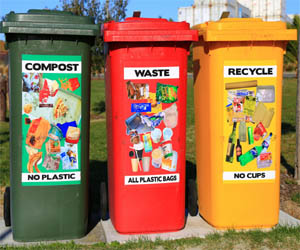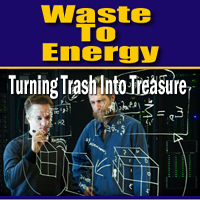


The Innovative World Of Waste-To-Energy Technology

In a world grappling with growing waste concerns and the need for sustainable energy sources, the concept of turning trash into power has emerged as a beacon of hope. Waste-to-energy (WTE) technology is at the forefront of this movement, offering an ingenious solution that not only manages waste efficiently but also harnesses its potential to generate electricity and heat. This transformative approach represents a win-win situation by reducing the burden on landfills and providing a sustainable power source.
The Waste-To-Energy Process
Waste-to-energy technology is a groundbreaking solution that transforms various types of waste materials, including municipal solid waste, agricultural residues, and industrial by-products, into electricity and heat. The process involves different techniques such as incineration, gasification, and anaerobic digestion, depending on the type of waste material being processed. Regardless of the method employed, the goal remains the same: extracting energy from waste.
Diverse Sources Of Waste
What makes the concept of turning trash into power so promising is the diversity of waste sources that can be utilized. It's not limited to just household waste; rather, it extends to agricultural and industrial waste streams. This versatility allows us to divert a significant portion of waste from landfills and turn it into a valuable resource.
Environmental Benefits
Waste-to-energy technology brings about a multitude of environmental benefits. Firstly, it reduces the need for landfill space, addressing the problem of limited landfill capacity. Landfills are notorious for releasing greenhouse gases and contaminating the environment, which can be mitigated through the use of WTE facilities. Moreover, the incineration process in these facilities is carefully controlled to minimize harmful emissions, contributing to cleaner air and a decrease in greenhouse gas emissions.
Reducing Fossil Fuel Dependency
One of the significant advantages of turning trash into power is its potential to reduce our dependence on fossil fuels. By utilizing waste materials as a source of energy, we decrease the demand for non-renewable resources. This transition aligns with the global push for a more sustainable energy mix and aids in reducing carbon emissions.
Economic And Social Benefits
Beyond environmental advantages, waste-to-energy initiatives bring economic and social benefits to communities. These facilities create jobs, stimulate local economies, and provide a stable source of revenue through the sale of surplus electricity to the grid. This not only fosters economic growth but also enhances the sustainability of waste management practices.
Challenges And Considerations
While the concept of turning trash into power is promising, it faces challenges such as public perception and concerns about emissions from incineration. It is essential to implement stringent regulations, advanced emission control technologies, and effective waste sorting systems to ensure that WTE facilities operate responsibly and safely.
The practice of turning trash into power is a monumental step toward a cleaner and more sustainable energy future. It addresses waste management concerns, reduces carbon emissions, and diminishes our reliance on fossil fuels. To fully harness the potential of this technology, continued investment in research, technology, and responsible waste-to-energy practices is essential. With ongoing commitment, we can turn our waste into a valuable resource and lead the way to a cleaner and more sustainable world.
A Guide To A Safe And Happy Environment
 Safety And Comfort: Crates offer a secure environment for your puppy, protecting them from household hazards, such as chewing on electrical cords or ingesting toxic substances. The crate can also serve as a cozy and familiar den where your pup feels safe and comfortable.
Safety And Comfort: Crates offer a secure environment for your puppy, protecting them from household hazards, such as chewing on electrical cords or ingesting toxic substances. The crate can also serve as a cozy and familiar den where your pup feels safe and comfortable.
Housebreaking: Crates are valuable tools for housebreaking. Puppies instinctively avoid soiling their living area. By confining your pup to the crate when you cannot supervise them, you encourage them to "hold it" until they can be taken outside for bathroom breaks.
Preventing Destructive Behavior: Puppies can be quite mischievous, and unsupervised exploration can lead to destruction. Crate training helps prevent unwanted chewing or digging, thus protecting your belongings.
Travel And Vet Visits: Crate-trained puppies are more comfortable during car rides and vet visits. They are familiar with the crate and see it as a safe and comforting place, reducing stress during these experiences.
Steps For Effective Crate Training
Choose The Right Crate: Select an appropriately sized crate for your puppy. It should be large enough for them to stand, turn around, and lie down comfortably. However, it shouldn't be so big that they can use one end as a bathroom.
Introduce Gradually: Allow your puppy to explore the crate at their own pace. Start by leaving the crate door open, placing some treats or toys inside to encourage them to enter. Make the crate a positive and inviting space.


Paving The Way For A Sustainable Future
 Renewable Energy Technologies: One of the most notable areas of green technology advancement is in renewable energy sources. Solar power, for instance, has witnessed tremendous growth, thanks to advancements in photovoltaic technology and the development of more efficient solar panels. Wind turbines have become increasingly effective, both in onshore and offshore applications. The integration of these technologies into the energy grid has paved the way for a cleaner and more sustainable energy future.
Renewable Energy Technologies: One of the most notable areas of green technology advancement is in renewable energy sources. Solar power, for instance, has witnessed tremendous growth, thanks to advancements in photovoltaic technology and the development of more efficient solar panels. Wind turbines have become increasingly effective, both in onshore and offshore applications. The integration of these technologies into the energy grid has paved the way for a cleaner and more sustainable energy future.
Energy Storage Solutions: Advancements in energy storage technologies are essential to overcoming the intermittency of renewable energy sources like wind and solar. Energy storage systems, including batteries and other innovative technologies, help store excess energy for use during periods of high demand or when renewable energy sources are not generating electricity.
Electric Vehicles (EVs): Green technology advancements have transformed the automotive industry. Electric vehicles (EVs) have become more affordable and accessible, with improved battery technologies leading to longer driving ranges and faster charging times. These EVs help reduce greenhouse gas emissions from the transportation sector.
Smart Grids: The development of smart grids is another noteworthy green technology advancement. Smart grids enhance the efficiency and reliability of energy distribution by integrating digital communication and control technologies. They empower consumers to better manage their energy consumption and contribute to more sustainable power generation.
Unraveling The Intricate Patterns In Fields
 Historical Roots
Historical Roots
The history of crop circles can be traced back to the early 1970s when the first reports of strange, circular patterns in crops emerged in the English countryside. These early formations were simple circles, far less intricate than the elaborate designs we see today. However, over the years, crop circles have evolved into complex geometric shapes, including spirals, fractals, and even depictions of animals and celestial bodies.
Intricate Geometric Patterns
One of the most striking aspects of crop circles is their precision and intricacy. These formations often display geometric shapes and mathematical properties that challenge conventional explanations. The precision with which they are created has left many experts scratching their heads, as achieving such accuracy in a short amount of time is a challenging feat for human-made formations.
Debates And Skepticism
The origin and purpose of crop circles have sparked numerous debates. Skeptics argue that the majority of crop circles are the result of elaborate hoaxes carried out by artists and pranksters using simple tools, like boards and ropes. They contend that these circles serve as a form of artistic expression or as a way to play pranks on the public.
Natural Phenomena And Weather Patterns
Some crop circle enthusiasts suggest that certain formations may be attributed to natural phenomena, such as unusual weather patterns or whirlwinds.






A Skeptical Perspective
 Skeptics also emphasize the lack of empirical evidence for Nostradamus' supposed prophetic abilities. They argue that belief in his predictions is largely rooted in confirmation bias, where believers selectively focus on the handful of quatrains that appear to match historical events while ignoring the majority that do not. The scientific method and the principles of critical thinking, which demand empirical evidence and verifiable predictions, are often conspicuously absent from the believers' claims.
Skeptics also emphasize the lack of empirical evidence for Nostradamus' supposed prophetic abilities. They argue that belief in his predictions is largely rooted in confirmation bias, where believers selectively focus on the handful of quatrains that appear to match historical events while ignoring the majority that do not. The scientific method and the principles of critical thinking, which demand empirical evidence and verifiable predictions, are often conspicuously absent from the believers' claims.
Moreover, critics highlight the historical context in which Nostradamus lived. His era was marked by political, religious, and social turmoil, and his quatrains can be viewed as a reflection of the uncertainties and anxieties of his time. Skeptics argue that his writings may have been more about capturing the spirit of the era than providing specific glimpses of the future. They maintain that the events he purportedly predicted can often be seen as general reflections of the historical climate of his time.
Another common target for debunking is the selective use of Nostradamus' quatrains by believers. Skeptics assert that proponents of Nostradamus often cherry-pick the quatrains that seem to match historical events while ignoring those that do not. This selective interpretation of his work contributes to the perception of his supposed prophetic abilities.

Hydration: Proper hydration is essential for cats, as they often don't drink enough water. Encourage water intake by placing multiple water bowls around the house and ensuring they are fresh and clean. Some cats prefer running water, so a cat water fountain may be a great investment.
Regular Vet Check-Ups: Regular visits to the veterinarian are crucial to detect and prevent health issues early. Annual check-ups, vaccinations, and dental care are essential for your cat's well-being. Cats are masters at hiding illness, so regular examinations are essential.
Vaccinations: Ensure your cat is up-to-date on vaccinations to protect them from common diseases. Discuss a vaccination schedule with your veterinarian based on your cat's lifestyle and risk factors.
Dental Care: Dental health is often overlooked but is integral to a cat's overall well-being. Brush your cat's teeth regularly and provide dental treats or toys to help maintain good oral health.
Grooming: Regular grooming is not only about maintaining a beautiful coat but also about monitoring your cat's health. Grooming sessions provide an opportunity to check for skin issues, fleas, and lumps or bumps.
Parasite Prevention: Keep your cat protected from parasites like fleas, ticks, and worms. Use preventative treatments recommended by your veterinarian to ensure your cat remains parasite-free.
Spaying And Neutering: Consider spaying or neutering your cat to prevent unwanted pregnancies and reduce the risk of certain health issues. Discuss the appropriate age and timing with your vet.
Litter Box Hygiene: Clean the litter box regularly to encourage proper litter box habits and maintain a clean environment. A dirty box can lead to stress and health problems.
Mental And Physical Stimulation: Cats need mental and physical stimulation to stay happy. Provide toys, scratching posts, and interactive play sessions to keep your cat engaged. Puzzle feeders can also challenge their minds.
Social Interaction: Cats are social animals, and their happiness is often linked to human and feline companionship. Spend quality time with your cat, and consider adopting a second cat to keep them company if they're alone for long periods.